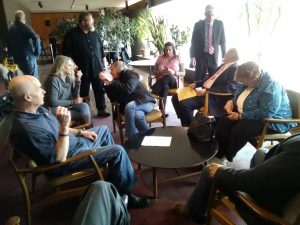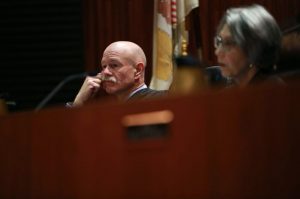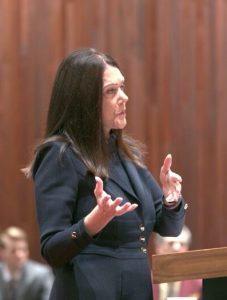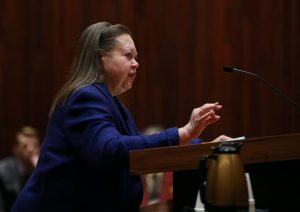Calusinski decision in hands of appellate court
By Gregory Harutunian For Chronicle Media — April 25, 2018
he family of Paul Calusinski and friends gather, prior to the start of oral arguments in Elgin. (Photo by Gregory Harutunian/for Chronicle Media)
The third stage of evidentiary hearings regarding the case of Melissa Calusinski and a redress on her 2011 conviction in the murder of 18-month-old Benjamin Kingan, at a Buffalo Grove day-care center, now awaits a decision from the three-judge panel of the Second Appellate Court in Elgin. No timetable was given for the determination from judges Michael Birk, Kathyrn Zenoff, and Mary Seminara-Schostok.
Defense attorney Kathleen Zellner’s filing in reply to the prosecution outlined several manifest errors in Calusinki’s two jury trials under the Brady Act, which encompasses evidence that was suppressed, withheld, or not presented. Chief among them were the child’s X-rays delivered in a diminished format for contrast resolution, the original trial judge assuming the role of radiologist, the assertion of a skull fracture as the cause of death, and one witness claiming to physically manipulate the fracture.
The April 18 hearing held to a rigid format of 15 minutes for oral arguments by both sides, and a five-minute defense rebuttal.
“Our court differs from the high court downstate, where they don’t read briefs, and go in cold, before reading the records,” said Robert Mangan, the second appellate circuit court clerk. “This court has the briefs and can ask specific questions … you have a response quicker in this situation, where everything can and will happen.”
An aspect of the oral arguments, Mangan said, is whether the new evidence if presented to the original juries would undermine the credibility of the guilty verdict. Nineteenth Circuit Court Judge Daniel Shanes presided over both Calusinski trials in Lake County, which ended in guilty verdicts and a 31-year sentence.

Appellate judges Michael Birkett and Kathryn Zenoof listen to oral arguments. (Photo courtesy Timothy Horstmann, CBS News)
Calusinski was accused of throwing down the child, causing the skull fracture that led to his death. Her conviction resulted from a taped nine-hour confession, faulty medical data, and the fracture that was later proven to be suture marks. Shanes also presided over evidentiary hearing in mid-2016, before denying the request for a new trial later that September, with a 53-page statement that maintaining the evidence was not new.
“The Brady violations of this evidentiary hearing can meet that burden of manifest errors,” Zellner said. “The state and defense were to work together to obtain readable X-Rays, and the defense is told the jpeg photos, with 90 percent of the information not there, was all they had, and illegible.” The original photos in a higher TIFF format showing no skull fracture, were stored on a computer in the county coroner’s office, and not made available for trial or to the jury for deliberations.
Shanes denied the new photos, and the first suppression placed him in the position of making a radiology decision about the transparencies, where the latter set showed no skull fracture, but suture lines where the skull fuses on an infant. The testimony of Dr. Robert Zimmerman, a pediatric neuro-radiologist, stated that a skull fracture with a “through and through clear line” would be impossible not to see on an X-ray.

Defense attorney Kathryn Zellner makes a point during arguments. (Photo courtesy Timothy Horstmann, CBS News)
One trial witness, Dr. Manuel Montez, of the coroner’s office, stated he had “manipulated” the fracture, running his fingers along the fracture’s ridge, and had blood on his hands. The testimony was refuted by Paul Foreman, the coroner’s office employee who took the X-rays, saying he had wiped the skull clean before Montez saw it, and was given the report to write up by then-county coroner Dr. Richard Keller.
The lower resolution 20KB jpeg photos also suffered from an inability to open a “tiger view” software program by the defense, as well as the prosecution indicating they would be the best quality available, when in fact, they were not.
Autopsy photos and histology slides of the Kingan body were reviewed and studied by former Lake County Coroner Dr. Thomas Rudd. That medical evidence highlighted a pre-existing subdural hematoma near the base of the skull. The attending autopsy physician, Dr. E. Choi, admitted making an error in the cause and manner of death for Kingan, and informed Assistant State’s Attorney Christen Bishop in a pre-trial meeting. Choi, in a letter obtained by the Chronicle, also indicates Bishop proceeded with the prosecution despite his statement.
“The condition was missed by Dr. Choi, Dr. Zimmerman’s opinion elevates this, Dr. Montez did not touch or feel a linear fracture, and with a clear TIFF image … these are big mistakes not to tell a jury,” said Zellner. “The medical evidence corroborates this, and also does not fit the rendition of Melissa Calusinski in the confession causing the injury.”
Judge Michael Birkett noted, “The skull fracture was the basis of the prosecution. Now the defense says there was no skull fracture … and you say it doesn’t damage the verdict?”

Prosecution attorney Mary Beth Burns answers questions from the appellate judges. (Photo courtesy Timothy Horstmann, CBS News)
Prosecution attorney, Mary Beth Burns, said, “The trials met the standards of review and upheld the determination, which was met on the weight of the evidence. Everything the state turned over was usable and capable of being opened. About the suppression, they could take the photo disk to a computer person and ask them to open it. The Brady claims of materiality come often … that information was withheld.”
After the hearing, Zellner said, “The judges were well-prepared. There are three options: they can review this for new trial, it can be denied and we go to the federal level, or they can recommend a new trial. One justice wondered why at the evidentiary trial, the judge was sitting in the role of a radiologist.”
Paul Calusinski, Melissa’s father, said, “I am hopeful … I just had surgery, and my daughter, Melissa, was more worried about me than her situation. That’s being a Calusinski. She needs to come home.”
—Calusinski decision in hands of appellate court–







